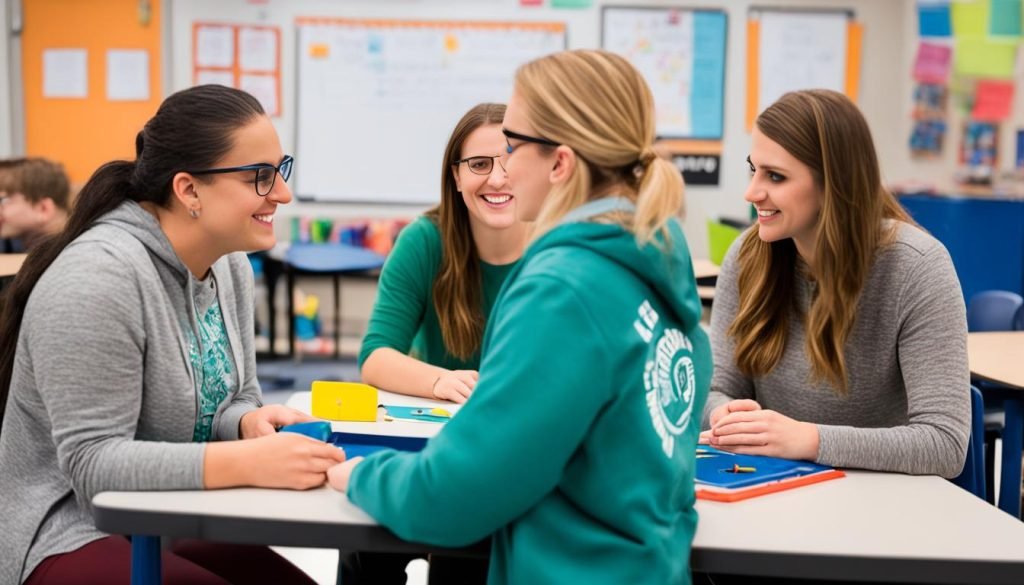According to the National Center on Universal Design for Learning, “UDL gives a way to create goals and methods that fit everyone. It’s not just one way for all. Instead, it’s about finding ways to teach that can change and adapt to each student.” Special education resources include tools and services that help students with diverse learning needs. They aim to make inclusive classrooms possible. In this article, we’ll look at how inclusive education works, what Universal Design for Learning (UDL) is, and the resources available to help teachers, families, and students.
Key Takeaways
- UDL provides a flexible framework for creating inclusive learning environments
- Special education resources support students with diverse learning needs
- Inclusive classrooms offer benefits for both students with disabilities and their peers
- Assistive technologies and accommodations can enhance accessibility and engagement
- Empowering educators and families is crucial for sustaining inclusive practices
Understanding Inclusive Education
General education and special education teachers see the good in inclusive education. It helps all students learn in ways that suit them best. This makes the classroom a place where everyone feels they belong. Many studies have backed the positive effects of inclusive classrooms. They show it leads to better learning, improved social skills, and less disruptive behavior for kids with and without disabilities.
Benefits of Inclusive Classrooms
Inclusive education makes room for students with all kinds of needs. This approach builds a community based on acceptance and working together. It helps all students learn important skills like empathy and problem-solving. With individualized education plans and differentiated instruction, every student can succeed.
Principles of Universal Design for Learning (UDL)
The Universal Design for Learning (UDL) model guides the creation of inclusive classrooms. It highlights letting students engage, learn, and show what they know in varied ways. UDL helps teachers meet each student’s learning style. This leads to better behavior management strategies and a more positive classroom vibe.
Examples of UDL Implementation
Using UDL in the classroom involves many strategies. This can include offering info in different ways, like audiobooks or videos. It also means letting students demonstrate their knowledge in ways they are best at, such as writing, speaking, or making videos. Flexibility in seating and using tech that helps different needs are also key. These UDL principles make learning accessible and engaging for everyone.
Tools and Services for special education resources
There’s a lot of great info on tools and services for special education. National groups like the Inclusive Schools Network and the National Center for Learning Disability are leading the way. They provide key programs and data on disabilities and how to include everyone in education.
National Organizations and Advocacy Groups
These groups are key in helping students with different learning needs. They empower families and push for fair education. They offer a lot, like special education plans and help in getting early support for families.
Assistive Technologies and Accommodations
Special technologies have changed how students with special needs learn. This includes special software, devices, and class changes for better access. All these can help students break through barriers and succeed in school and life.
Early Intervention and Family Support
Starting early and family help are very important for kids with special needs. The National Center for Learning Disability is there to support families. They help with special education, making sure kids get the support they need from the start.
| Organization | Focus Area | Resources Offered |
|---|---|---|
| Inclusive Schools Network | Inclusive education, advocacy | Professional development, family support, policy guidance |
| National Center for Learning Disability | Learning disabilities, educational accommodations | Individualized education plans, assistive technology, early intervention services |
| TASH | Disability rights, inclusive communities | Advocacy, research, policy analysis, networking opportunities |

Creating an Inclusive Learning Environment
To foster an inclusive learning space, it’s vital to follow Universal Design for Learning (UDL) principles. This method focuses on engaging students with varied preferences and needs. It does so by offering several ways to learn and participate.
Applying Universal Design Principles
UDL brings flexibility by allowing educators to tailor teaching to each student. Providing various learning materials like audio, visuals, or activities ensures everyone can learn effectively. This approach meets different student styles and challenges.
Differentiating Instruction and Assessment
For inclusive spaces, varied teaching and assessment are key. Teachers can use different teaching methods and ways to test understanding. By creating individualized education plans and using various assessment strategies, educators ensure every student can excel.
Developing Behavior Management Strategies
Managing behavior well is critical for a supportive classroom atmosphere. Teachers should set understandable rules and offer reliable routines. They must use approaches that tackle the emotional and behavioral needs of all. This makes the place safe and inviting for everyone, promoting academic and social success.
Empowering Educators and Families
Empowering both educators and families is key to creating inclusive learning spaces. The Association for Supervision and Curriculum Development (ASCD) provides many resources for professional growth. These cover topics like inclusive education and special education.
This includes workshops, webinars, and online courses. They help teachers support all students, especially those with diverse learning needs.
Professional Development Resources
ASCD’s programs focus on important areas like differentiated instruction and behavior management. They also help with UDL principles. Educators learn how to make education plans specific to students and to use helpful technologies.
They also work on building strong partnerships with families. This ensures the success of students’ academic and emotional well-being.
Parent Advocacy and Support Networks
Equally, empowering families is vital. Many support networks help parents understand and navigate special education. Places like the National Center for Learning Disabilities and TASH offer lots of help online.
Through these resources, parents can better support their children. They learn how to talk with teachers and get the support their child needs.
Supporting both educators and families is crucial. This approach helps create schools where everyone thrives. It ensures all students find the support they need and promotes fair education for all.


